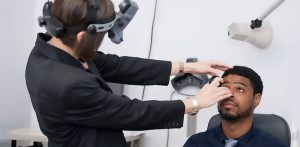What is third nerve palsy?
Third nerve palsy, also called oculomotor palsy, occurs when the third cranial nerve becomes injured or diseased.
The third cranial nerve controls the actions of four external eye muscles. These muscles are responsible for turning the eye inward, moving the eye upward and downward, and rotating the eye downward and outward toward the ear.
The third cranial nerve also controls pupil constriction, upper eyelid position and eye focusing abilities.
As the third nerve controls many of the eye’s muscles, palsy of this nerve can result in complete or partial paralysis of the eye muscles.
A complete paralysis of the eye muscles generally leads to an outward and downward eye deviation, while a partial paralysis leads to an outward eye turn.
Similarly, a complete paralysis of the eye muscles typically results in a complete closure of the eyelid, while a partial paralysis usually results in a droopy eyelid.
What are the symptoms of third nerve palsy?
- Double vision (diplopia)
- Eye misalignment (strabismus)
- Droopy eyelid (ptosis)
- Enlarged pupil that does not react normally to light
- Tilted head posture to compensate for binocular vision difficulties
If you experience any of the above symptoms, contact an eye doctor near you.
SEE RELATED: Vision and Brain Injuries
What causes third nerve palsy?
Third nerve palsy may be congenital or acquired. While the cause of a congenital palsy may not be identifiable, an acquired palsy may result from:
- Birth trauma
- Head injury
- Infection
- Vaccination
- Migraine
- Brain tumor
- Aneurysm
- Diabetes
- Hypertension
How is third nerve palsy diagnosed?
An eye doctor may be able to diagnose third nerve palsy, but may refer you to a neuro-ophthalmologist or neurologist for confirmation.
A series of diagnostic tests, including a neurological exam and MRI or CT scan, will be performed in order to effectively identify a third nerve palsy.
How is third nerve palsy treated?
Unfortunately, treatment for congenital third nerve palsy has yet to be discovered.
If the palsy is acquired, treatment will depend on the underlying cause of the condition.
Surgery may be recommended if a tumor or aneurysm is pressing on the nerve, to relieve the pressure on the nerve and promote healing.
To reduce or eliminate double vision and improve eye alignment, the following treatments may be recommended:
- Vision therapy
- Patching one eye to improve binocular vision
- Prism lenses to reduce or eliminate double vision
- Eye muscle surgery to realign the eyes
- Eyelid surgery to correct the ptosis
Vision therapy is an effective treatment option for some patients with third nerve palsy, as it can help to improve eye movements and binocular vision.
If you notice any sudden changes to your vision, especially double vision or an eye turn, schedule an eye exam as soon as possible.
LEARN MORE: Guide to Vision Therapy for Adults
The sooner fourth nerve palsy is diagnosed, the greater your chances of optimal treatment results.









